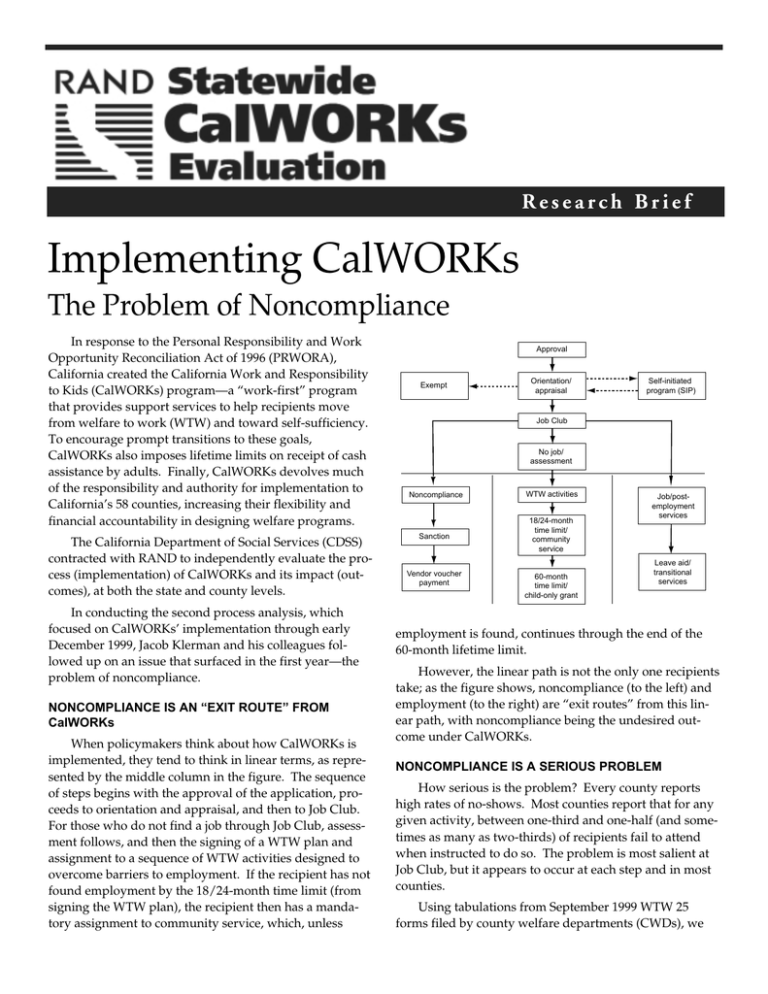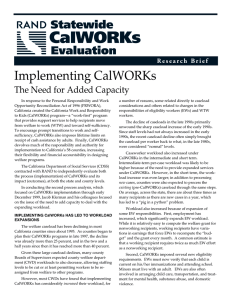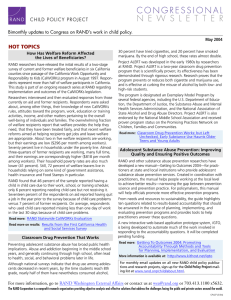Implementing CalWORKs The Problem of Noncompliance
advertisement

Research Brief Implementing CalWORKs The Problem of Noncompliance In response to the Personal Responsibility and Work Opportunity Reconciliation Act of 1996 (PRWORA), California created the California Work and Responsibility to Kids (CalWORKs) program—a “work-first” program that provides support services to help recipients move from welfare to work (WTW) and toward self-sufficiency. To encourage prompt transitions to these goals, CalWORKs also imposes lifetime limits on receipt of cash assistance by adults. Finally, CalWORKs devolves much of the responsibility and authority for implementation to California’s 58 counties, increasing their flexibility and financial accountability in designing welfare programs. The California Department of Social Services (CDSS) contracted with RAND to independently evaluate the process (implementation) of CalWORKs and its impact (outcomes), at both the state and county levels. In conducting the second process analysis, which focused on CalWORKs’ implementation through early December 1999, Jacob Klerman and his colleagues followed up on an issue that surfaced in the first year—the problem of noncompliance. NONCOMPLIANCE IS AN “EXIT ROUTE” FROM CalWORKs When policymakers think about how CalWORKs is implemented, they tend to think in linear terms, as represented by the middle column in the figure. The sequence of steps begins with the approval of the application, proceeds to orientation and appraisal, and then to Job Club. For those who do not find a job through Job Club, assessment follows, and then the signing of a WTW plan and assignment to a sequence of WTW activities designed to overcome barriers to employment. If the recipient has not found employment by the 18/24-month time limit (from signing the WTW plan), the recipient then has a mandatory assignment to community service, which, unless Approval Exempt Orientation/ appraisal Self-initiated program (SIP) Job Club No job/ assessment Noncompliance WTW activities Sanction 18/24-month time limit/ community service Vendor voucher payment 60-month time limit/ child-only grant Job/postemployment services Leave aid/ transitional services employment is found, continues through the end of the 60-month lifetime limit. However, the linear path is not the only one recipients take; as the figure shows, noncompliance (to the left) and employment (to the right) are “exit routes” from this linear path, with noncompliance being the undesired outcome under CalWORKs. NONCOMPLIANCE IS A SERIOUS PROBLEM How serious is the problem? Every county reports high rates of no-shows. Most counties report that for any given activity, between one-third and one-half (and sometimes as many as two-thirds) of recipients fail to attend when instructed to do so. The problem is most salient at Job Club, but it appears to occur at each step and in most counties. Using tabulations from September 1999 WTW 25 forms filed by county welfare departments (CWDs), we can construct a “snapshot” of where participants fell within the paths shown in the figure. We estimate that 22 percent of the CWDs’ mandatory workload is on the linear path; 29 percent is employed; and 20 percent is formally noncompliant (including those sanctioned). But this 20 percent understates the magnitude of noncompliance. Many participants are unaccounted-for, including the noshows for whom the county has not yet begun the formal noncompliance process. REASONS FOR NONCOMPLIANCE VARY While the problem of noncompliance is clear, the reasons for it are less so. Our analysis suggests three reasons: First, because of CWD deficiencies, recipients may not be receiving or understanding notices, or they may have either easily remediable but unaddressed barriers to participation (e.g., being unaware that the CWD will pay for child care) or serious but unrecognized barriers (e.g., learning disabilities). Second, participants may be fearful of participating in a WTW step (usually Job Club). Finally, there is willful noncompliance—recipients simply choose not to participate, perhaps because they are already working “under the table” and participating (e.g., in Job Club) would force them to forfeit their jobs. When recipients do not comply, sanctions that cut recipient benefits can be used. Given the consistently high reported rates of no-shows in early CalWORKs activities and the provisions of the CalWORKs legislation, one would expect high sanction rates. However, the rates tend to be lower than expected. Our county interviews show that at the beginning of CalWORKs, many counties were simply too busy dealing with compliant cases to sanction; even now, some counties are reluctant to sanction, preferring instead to encourage participation. Moreover, there is widespread concern that the statutory adult-only sanction (for a family of three, the loss of $121 of the $626 grant) is too small to have the desired effect of discouraging willful noncompliance. IMPLICATIONS FOR POLICYMAKERS HOME VISITS AND SANCTIONS ARE OPTIONS FOR DEALING WITH NONCOMPLIANCE While home visits are a promising strategy for dealing with the serious problem of noncompliance, they are timeconsuming, and, to be done properly, they require specially trained staff. As noted, many counties have pilot home visit programs in place or under development, but a universal home visit program—whether immediately following noncompliance or after imposition of sanctions— would require committing major resources. Conducting a multicounty, randomized experiment to identify the effects of various home visit strategies is feasible and worthy of serious consideration. Regardless of the cause, counties report that home visits—which many counties are implementing or piloting— are a potentially useful strategy for dealing with it. Observers claim that the interaction between a CWD staff person and recipients during such home visits can help identify and address CWD deficiencies. Home visits also provide a natural vehicle for motivating compliance among the reluctant and fearful. Finally, home visits can help identify fraud—to determine, for example, if the recipients are not available for a home visit because they are working, if the children are not present, or if other adults appear to be living in the household. Whether counties should be given the option of a fullfamily, as opposed to adult-only, sanction requires weighing two considerations. First, the effect of a full-family sanction on participation must be considered. While there are claims (from the state of Hawaii and from a recently suspended demonstration in San Mateo County) that fullfamily sanctions increase compliance, the formal evaluation evidence is mixed. Second, there are real concerns about the effects of full-family sanctions on the children the CalWORKs program is intended to protect. As the results of several ongoing studies of full-family sanctions become available, the state could revisit this option. The research summarized in this Research Brief was carried out within RAND’s Labor & Population Program. Research results are described in detail in MR-1177-CDSS, Welfare Reform in California: State and County Implementation of CalWORKs in the Second Year, Jacob Klerman et al., 2000 (416 pp., $25) and its accompanying Executive Summary, MR-1177/1-CDSS, (28 pp., $8). Both documents are available electronically at http://www.rand.org/CalWORKs or through RAND Distribution Services (Telephone: 310-451-7002; FAX 310-451-6915; Internet: order@rand.org). Abstracts of RAND documents may be viewed on the World Wide Web (http://www/rand.org). RAND® is a registered trademark. RAND is a nonprofit institution that seeks to improve policy and decisionmaking through research and analysis; its publications do not necessarily reflect the opinions or policies of its research sponsors. R 1700 Main Street, P.O. Box 2138, Santa Monica, California 90407-2138 • Telephone 310-393-0411 • FAX 310-393-4818 1200 South Hayes Street, Arlington, VA 22202-5050 • Telephone 703-413-1100 • FAX 703-413-8111 RB-5038 (2000)




